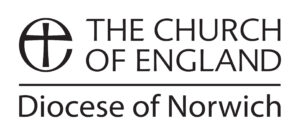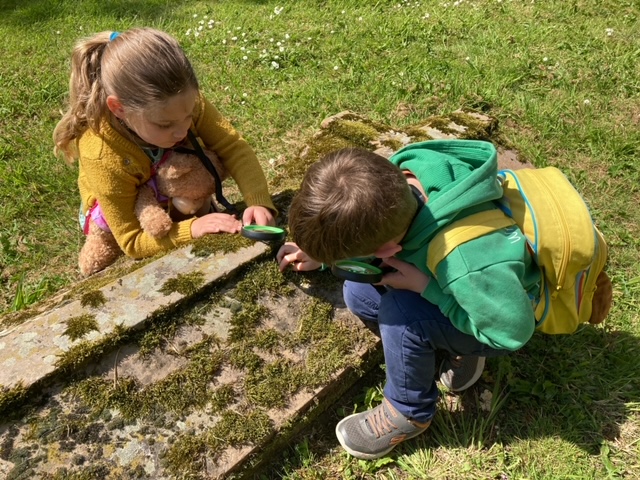Churches Count on Nature (CCoN) is part of Love Your Burial Ground Week, an annual event which is open to anyone with a love of nature and any church that has land. Churches are encouraged to connect with local schools, wildlife groups, and those who may not have visited before to discover their churchyards.
Bishop Graham says, “The event helps us determine the level of biodiversity in our churchyards and is a great opportunity to bring people of all ages together to appreciate the natural world. As Christians, we have a responsibility to care for God’s creation, and participating in Churches Count on Nature is just one way in which we can demonstrate that care.”
For those churches who are already registered as part of the A Rocha UK Eco Church scheme, participating in this event helps with their journey towards an award.
Symbolism in plants at St Mary’s Newton Flotman, Tas Valley Benefice
We registered our event as part of our regular ECO (Encountering Creation Outside) Church monthly 4pm service. We used ‘iNaturalist’ to record the plants we have in our churchyard and several resources from CCoN to help identify wildlife in our churchyard. We chose ‘Christian symbolism in nature’ as our theme and started by chalking holly, clover, yew, and ivy onto the church path. These chalk drawings are a tradition for every ECO church and are commented on and enjoyed by the community as passers-by see these drawings through the week (or more if it doesn’t rain!).
We nibbled strawberries while introducing the topic of the day to all, ages ranging from two to 91 years! We hunted for symbolic plants and mapped where they were in the churchyard, then discussed their symbolism. We liked the plantain as a symbol of the pilgrims’ journey as they are often found along the edges of paths. Refreshments, and a time of prayer ended the session with many taking plants home to put into their own creation spaces! We are planning to have a space in our porch to leave the wildlife guides and keys for visitors to interpret the nature of our churchyard.
Kirsten Remer, AWA
“Zebras” discovered at St. Bartholomew’s, Brisley
On one of the hottest days of the summer about 20 adults and several children arrived at St. Barts to explore our burial ground. We were fortunate in having the assistance of our local ecologist, Robert Yaxley, to help us with our exploration and identification of what we found. The plan was to find some rare and different flora and fauna, and also identify numerous creepy crawlers which were hidden in the outside of the building or around the burial ground.
Most of the adults attending had never previously visited the church. Even those who had been inside the church had never previously explored the burial ground. It was fascinating to see what was hidden under various stones and in the crevices of the church building. A beautiful Zebra spider was of particular interest. Using magnifying glasses many unusual wild plants were discovered, a few of which, we were very surprised to learn, tend only to be found in burial grounds which have been left to nature and wildlife and have been left a bit neglected!
Many acknowledged from their visit, that it made them aware that we rarely notice what is under our feet, unless we stop and truly appreciate the beauty of God’s creation.
Mary Carden, PCC Member
Wildlife at Wymondham Abbey
Our cherished plot has a herb garden, paths, picnic tables and benches with views across the tranquil Abbey meadow. It’s a haven for wildlife, bursting with birdsong, insects, trees and wildflowers.
We partnered with Wymondham Nature Group and Greening Wymondham to invite our local community to come and found out more with an afternoon of free activities. From Looking at lichens and bird and animal skulls, to craft activities and a chance to help with our annual churchyard wildlife count using the iNaturalist app to record and photograph churchyard wildlife and plants. “It had a lovely sense of community cohesion and engagement, and the change to network with others was invaluable,” said one partnering participant.
Hilary Hunter
New discoveries at St Faith’s, Gaywood
From five-years-old to well over retirement age, a mixture of our congregation and the wider community, sixteen of us met on a lovely sunny afternoon in St Faith’s churchyard for our second CCoN event.
Once again, we invited people to come and sit in the churchyard for 20 minutes and record all the plants, insects, birds and mammals that they saw. We discovered a total of 55 species of flowering plants and 16 species of trees – a slightly higher total from last year with some exciting new finds.
There was a big increase in birds identified (16 species) with some wonderful new sightings – a green woodpecker, a chiffchaff, and even an owl. Sadly, there were no sightings of butterflies this year and perhaps due to the colder weather last month.
There was a lovely atmosphere at the event with people excitedly sharing their discoveries and puzzling together over the identification of some of the more obscure species. We felt truly blessed, not only to have such a rich and diverse habitat surrounding our church but also having a group of people who were so clearly enjoying the event.
Daphne Sampson, Eco Church lead
St Andrew’s, Trowse was buzzing
A bee day was held at Trowse parish church on 3rd June as part of CCoN.
One of our congregation members, Graham, is a beekeeper. He brought along an observation hive so that we could all watch the bees in action. Graham was busy telling approximately 80 visitors, including many children, about the life of bees, the best plants for food and their importance in nature. We were surprised to learn that the highest sugar content is to be found in horse chestnut flowers with dandelions also high on the list. We are fortunate to have several horse chestnut trees in our churchyard.
In addition, visitors were able to make candles out of beeswax, paint stones to look like bees and do other bee related activities. Some children went into the churchyard to see what wildlife they could find. An Azure Hawker Dragonfly and a Small Red Damselfly were spotted.
Sarah Toothill, Eco Church lead
Sensory highlights at St Mary’s & St Michael’s, Reepham
For the third year, Reepham Church took part in CCoN: counting what calls our churchyard home and encouraging people to come and see what lives within it. A total of 120 species of wildlife were found, from the flowers in our conservation areas, to lichens and mosses, ants, woodlice and much more.
We held a Churchyard Wildlife Day where participants could follow a sensory trail: looking; listening; smelling; touching and counting. We encouraged people to look carefully at the flowers and record which colours were attractive to insects: the blue flowers of Alkanet were the most visited by bees. The highlight of the day was the discovery of the exuvia (nymph case) of a damselfly on the emergent vegetation of our washing- up bowl pond! The bowl had been sunk into the wildlife-friendly garden in May 2022, filled using rainwater, with oxygenating weed and an emergent plant being added. A damselfly must have laid its eggs on the leaves; the nymph hatched and developed to emerge as an adult. Ann, an elderly member of the congregation said; “That is amazing! I must ask my son to make one in my garden.”
Rachel Richmond, Eco Church lead
A whole host of eco activities at All Saints, Hemblington
CCoN and Great Big Green Week were celebrated at Hemblington church with a series of events from 3 – 18 June. The Friends of All Saints Church organised an exhibition in church of the wild flora and fauna seen over recent years as well as promoting local wildlife conservation charities.
One Saturday, people joined us for our monthly churchyard wildlife survey, along with a drop-in session for visitors to discuss and share ideas and reflect on how to play our part as individuals and as a local community to live more sustainably and address the challenges of climate change. Leaflets were given out with simple ideas on how to make small changes in lifestyle.
People also enjoyed two free talks by local naturalists David Bryant and Garth Coupland; “How to see more Birds” and “Reptiles and Amphibians of Norfolk” encouraging the audience to look more closely at wildlife in their immediate area, the importance of habitat protection and the effects of climate change. Classes from Hemblington School visited, looking at moths in a trap set up the previous evening, leaf and bark rubbing, planting sunflower seeds, bug hunting and discussing home composting.
The Local Conservation Group (BADCOG) cut and composted the wildflowers in the churchyard with visitors encouraged to observe or join in if they wished. And on the final Sunday we held a “Creation Sunday Service”, including distributing an individual eco-audit to the congregation.
Simon Mutten, Churchwarden
Holt scored a century!
During Count on Nature week (5 – 10 June ), 101 species of plant were recorded in St Andrew’s churchyard in Holt. As well as being attractive to the eye, these will support hundreds of small organisms including our honey bees. The Norfolk lichen expert Rob Yaxley also visited and recorded an amazing 53 species of lichen. It was the first time that we had taken part in this event. We were extremely lucky to have local naturalist Tony Leech to lead us in exploring different
areas of our town each day. We also visited All Saints High Kelling churchyard, Holt Methodist Church, the Methodist Memorial Garden, and Holt Town Cemetery. A wildflower walk took place on Spout Hills (a local nature reserve) and a mini-beast hunt for pupils at Holt Community Primary School.
We had advertised the week’s events and were pleased at how many people joined in. Stephen Gillam, Chair of our Eco Church group, has built useful links with other local organizations. As with many other churchyards, there are differences between those who wish them to be kept neat and tidy and those who wish for as diverse a wildlife habitat as possible. One of the benefits of the week was to be able to demonstrate how our management plan was working, helped by six new explanatory boards around the churchyard that are proving popular with all ages.
From this event we took several useful lessons: to leave plenty of time at each site, to make allowances for the physically less able, to have a disciplined keeper of records AND that although resource apps and booklets are helpful, nothing beats a local botanist with expertise and enthusiasm. As one participant said “As a non-botanist, I was flabbergasted by how much we found – and learnt.”
Fiona Joliffe, Eco Church coordinator


